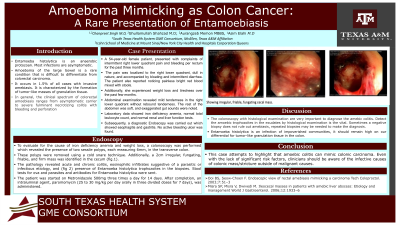Monday Poster Session
Category: Colon
P2013 - Amoeboma Mimicking as Colon Cancer: A Rare Presentation of Entamoebiasis
Monday, October 28, 2024
10:30 AM - 4:00 PM ET
Location: Exhibit Hall E

Has Audio

Chanpreet Singh, MD
Texas A&M School of Medicine
New Hyde Park, NY
Presenting Author(s)
Chanpreet Singh, MD1, Ghullamullah Shahzad, MD2, Aurangzeb Memon, MBBS3
1Texas A&M School of Medicine, New Hyde Park, NY; 2Icahn School of Medicine at Mount Sinai, Fresh Meadows, NY; 3Icahn School of Medicine at Mount Sinai, Queens, NY
Introduction: Entamoeba histolytica is an anaerobic protozoan. Most infections are asymptomatic. Amoeboma of the large bowel is a rare condition which is difficult to differentiate from colorectal carcinoma. It occurs in 1.5% of all cases with invasive amebiasis. It is characterized by formation of tumor like masses of granulation tissue.
Case Description/Methods: A 54-year-old female patient, presented with complaints of intermittent right lower quadrant pain and bleeding per rectum for the past three months. The pain was localized to the right lower quadrant, dull in nature, and accompanied by bloating and intermittent diarrhea. The patient also reported noticing painless bright red blood mixed with stools. Additionally, she experienced weight loss and tiredness over the past few months. Abdominal examination revealed mild tenderness in the right lower quadrant without rebound tenderness. The rest of the abdomen was soft, and exaggerated gut sounds were noted. Laboratory data showed iron deficiency anemia, normal total leukocyte count, and normal renal and liver function tests. Subsequently, diagnostic Endoscopy was carried out which showed esophagitis and gastritis. No active bleeding ulcer was found. To evaluate for the cause of iron deficiency anemia and weight loss, colonoscopy was performed which revealed the presence of two sessile polyps, each measuring 6mm, in the transverse colon. These polyps were removed using a cold snare technique. Additionally, a 2cm irregular, fungating, friable, and firm mass was identified in the cecum (fig.1). The pathology revealed acute and chronic colitis, eosinophilic infiltrates suggestive of a parasitic or infectious etiology, and (fig 2) presence of Entamoeba histolytica trophozoites in the biopsies. Stool tests for ova and parasites and antibodies for Entamoeba histolytica were sent. The patient was started on Metronidazole 500mg three times a day for 14 days. After completion, an intraluminal agent, paromomycin (25 to 30 mg/kg per day orally in three divided doses for 7 days), was administered.
Discussion: This case attempts to highlight that amoebic colitis can mimic colonic carcinoma. Even with the lack of significant risk factors other than HIV, clinicians should be aware of the infective causes of colonic mass/stricture outside of malignant causes. Entamoeba histolytica is an infection of impoverished communities, it should remain high on our differential for tumour-like granulation tissue in the colon.

Disclosures:
Chanpreet Singh, MD1, Ghullamullah Shahzad, MD2, Aurangzeb Memon, MBBS3. P2013 - Amoeboma Mimicking as Colon Cancer: A Rare Presentation of Entamoebiasis, ACG 2024 Annual Scientific Meeting Abstracts. Philadelphia, PA: American College of Gastroenterology.
1Texas A&M School of Medicine, New Hyde Park, NY; 2Icahn School of Medicine at Mount Sinai, Fresh Meadows, NY; 3Icahn School of Medicine at Mount Sinai, Queens, NY
Introduction: Entamoeba histolytica is an anaerobic protozoan. Most infections are asymptomatic. Amoeboma of the large bowel is a rare condition which is difficult to differentiate from colorectal carcinoma. It occurs in 1.5% of all cases with invasive amebiasis. It is characterized by formation of tumor like masses of granulation tissue.
Case Description/Methods: A 54-year-old female patient, presented with complaints of intermittent right lower quadrant pain and bleeding per rectum for the past three months. The pain was localized to the right lower quadrant, dull in nature, and accompanied by bloating and intermittent diarrhea. The patient also reported noticing painless bright red blood mixed with stools. Additionally, she experienced weight loss and tiredness over the past few months. Abdominal examination revealed mild tenderness in the right lower quadrant without rebound tenderness. The rest of the abdomen was soft, and exaggerated gut sounds were noted. Laboratory data showed iron deficiency anemia, normal total leukocyte count, and normal renal and liver function tests. Subsequently, diagnostic Endoscopy was carried out which showed esophagitis and gastritis. No active bleeding ulcer was found. To evaluate for the cause of iron deficiency anemia and weight loss, colonoscopy was performed which revealed the presence of two sessile polyps, each measuring 6mm, in the transverse colon. These polyps were removed using a cold snare technique. Additionally, a 2cm irregular, fungating, friable, and firm mass was identified in the cecum (fig.1). The pathology revealed acute and chronic colitis, eosinophilic infiltrates suggestive of a parasitic or infectious etiology, and (fig 2) presence of Entamoeba histolytica trophozoites in the biopsies. Stool tests for ova and parasites and antibodies for Entamoeba histolytica were sent. The patient was started on Metronidazole 500mg three times a day for 14 days. After completion, an intraluminal agent, paromomycin (25 to 30 mg/kg per day orally in three divided doses for 7 days), was administered.
Discussion: This case attempts to highlight that amoebic colitis can mimic colonic carcinoma. Even with the lack of significant risk factors other than HIV, clinicians should be aware of the infective causes of colonic mass/stricture outside of malignant causes. Entamoeba histolytica is an infection of impoverished communities, it should remain high on our differential for tumour-like granulation tissue in the colon.

Figure: Showing irregular, friable, fungating cecal mass.
Disclosures:
Chanpreet Singh indicated no relevant financial relationships.
Ghullamullah Shahzad indicated no relevant financial relationships.
Aurangzeb Memon indicated no relevant financial relationships.
Chanpreet Singh, MD1, Ghullamullah Shahzad, MD2, Aurangzeb Memon, MBBS3. P2013 - Amoeboma Mimicking as Colon Cancer: A Rare Presentation of Entamoebiasis, ACG 2024 Annual Scientific Meeting Abstracts. Philadelphia, PA: American College of Gastroenterology.
